A water dog is a type of gundog bred to flush and retrieve game from water.
Contents
Water dog, waterdog or water-dog may also refer to:
A water dog is a type of gundog bred to flush and retrieve game from water.
Water dog, waterdog or water-dog may also refer to:

Scent hounds are a type of hound that primarily hunts by scent rather than sight. These breeds are hunting dogs and are generally regarded as having some of the most sensitive noses among dogs. Scent hounds specialize in following scent or smells. Most of them tend to have long, drooping ears and large nasal cavities to enhance smell sensitivity. They need to have relatively high endurance to be able to keep track of scent over long distances and rough terrain. It is believed that they were first bred by the Celts by crossbreeding mastiff-type dogs with sighthounds. The first established scent hounds were St. Hubert Hounds bred by monks in Belgium during the Middle Ages.
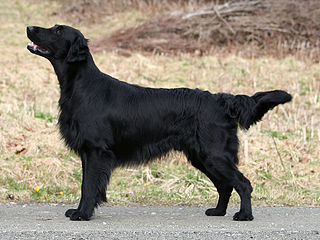
The Flat-coated Retriever is a gun dog breed originating from England. It was developed as a retriever both on land and in the water.
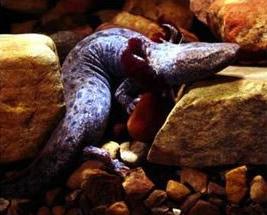
The family Proteidae is a group of aquatic salamanders found today in the Balkan Peninsula and North America. The range of the genus Necturus runs from southern central Canada, through the midwestern United States, east to North Carolina and south to Georgia and Mississippi. The range of the olm, the only extant member of the genus Proteus, is limited to the Western Balkans. The fossil record of the family extends into the end of the Late Cretaceous, with Paranecturus being known from the Maastrichtian of North America.

A spaniel is a type of gun dog. Spaniels were especially bred to flush game out of denser brush. By the late 17th century, spaniels had been specialized into water and land breeds. The extinct English Water Spaniel was used to retrieve water fowl shot down with arrows. Land spaniels were setting spaniels—those that crept forward and pointed their game, allowing hunters to ensnare them with nets, and springing spaniels—those that sprang pheasants and partridges for hunting with falcons, rabbits and smaller mammals such as rats and mice for hunting with greyhounds. During the 17th century, the role of the spaniel dramatically changed as Englishmen began hunting with flintlocks for wing shooting. Charles Goodall and Julia Gasow (1984) write that spaniels were "transformed from untrained, wild beaters, to smooth, polished gun dogs."
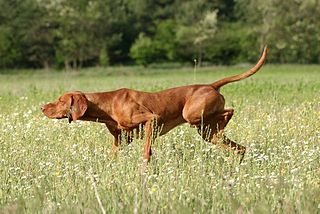
Pointing dogs, sometimes called bird dogs, are a type of gundog typically used in finding game. Gundogs are traditionally divided into three classes: retrievers, flushing dogs, and pointing breeds. The name pointer comes from the dog's instinct to point, by stopping and aiming its muzzle towards game. This demonstrates to the hunter the location of their quarry and allows them to move into gun range. Pointers were selectively bred from dogs who had abundant pointing and backing instinct. They typically start to acquire their hunting instincts at about 2 months of age.
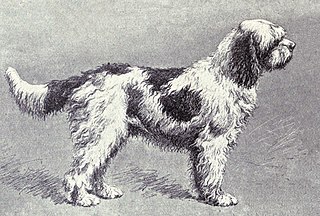
A water dog is a type of gundog bred to flush and retrieve game from water. Water dogs are considered the progenitors of most modern retriever dog breeds.
Springer or springers may refer to:
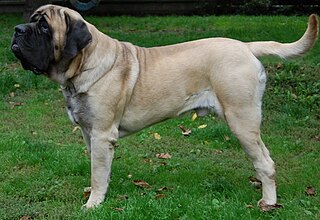
The English Mastiff, or simply the Mastiff, is a British dog breed of very large size. It is likely descended from the ancient Alaunt and Pugnaces Britanniae, with a significant input from the Alpine Mastiff in the 19th century. Distinguished by its enormous size, massive head, short coat in a limited range of colours, and always displaying a black mask, the Mastiff is noted for its gentle and loving nature. The lineage of modern dogs can be traced back to the early 19th century, but the modern type was stabilised in the 1880s and refined since. Following a period of sharp decline, the Mastiff has increased its worldwide popularity. Throughout its history the Mastiff has contributed to the development of a number of dog breeds, some generally known as mastiff-type dogs or, confusingly, just as "mastiffs". It is the largest living canine, outweighing the wolf by up to 50 kg (110 lbs) on average.
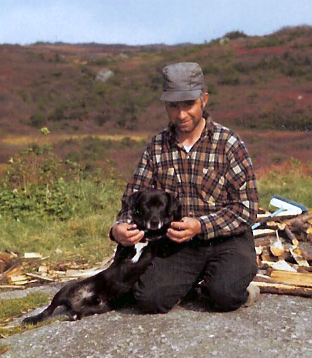
The St. John's water dog, also known as the St. John's dog or the lesser Newfoundland, is an extinct landrace of domestic dog from Newfoundland. Little is known of the types that went into its genetic makeup, although it was probably a random-bred mix of old English, Irish and Portuguese working dogs. They were favourite dogs of fishermen because they had extraordinary qualities like good temperament and working behaviour. The number of St. John's water dogs started declining by the beginning of the 20th century. By the early 1980s, the landrace was extinct.
Indian dog may refer to:

The Bakharwal dog is a livestock guardian dog found in northern India. It is an ancient working Indian dog breed found in Ladakh and across the Pir Panjal Range of Jammu and Kashmir, India.

The Hawaiian Poi Dog is an extinct breed of pariah dog from Hawaiʻi which was used by Native Hawaiians as a spiritual protector of children and as a source of food.

The Tweed Water Spaniel, or Tweed Spaniel, is a breed of dog extinct since the 19th century. It is best known for being involved in the early development of the modern Curly Coated Retriever and Golden Retriever breeds of dogs. They were described as generally brown, athletic dogs from the area around Berwick-upon-Tweed near the River Tweed and close to the Scottish Borders. A type of water dog, the breed was not well known outside the local area. This breed may have been created by crossing local water dogs with imported St. John's water dog, another breed which is also now extinct.
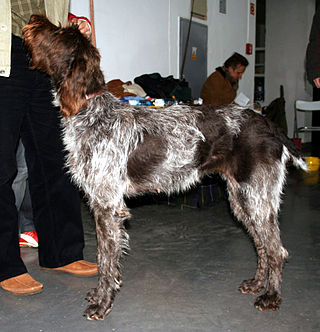
The Český Fousek is a Czech breed of versatile hunting dog that was traditionally and currently used to hunt, point, and retrieve. This refers to the dog's natural ability in tracking, pointing, and retrieving game. The name is in Czech, in which český means Czech and fousek is derived from vousy or vousky (whiskers). While the name is used for both sexes, Český Fousek specifically refers to a male dog while the female is traditionally called Česká Fouska. The breed is part of the griffon hunting dog family and have the beard and moustache common to wirehairs. There is a large difference in size between the females and males of this breed, with the weight difference being up to 11 kilograms (24 lb).

The Wetterhoun is a breed traditionally used as a hunting dog for small game and waterfowl and native to the province of Friesland in the Netherlands. The name of the breed comes from the West Frisian Wetterhûn, meaning "water dog." The plural of Wetterhoun is Wetterhounen in Frisian. The breed may also be called the Otterhoun or Dutch Spaniel, although it is not a Spaniel-type dog.
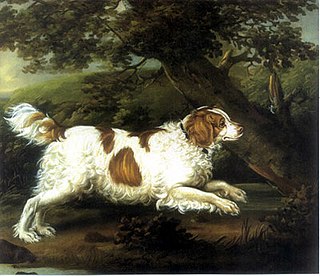
The English Water Spaniel is a breed of dog that has been extinct since the first part of the 20th century, with the last specimen seen in the 1930s. It was best known for its use in hunting waterfowl and for being able to dive as well as a duck. It is described as similar to a Collie or to a cross between a Poodle and a Springer Spaniel with curly fur and typically in a white and liver/tan pattern.
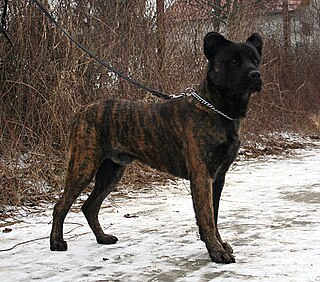
The Saint Miguel Cattle Dog is a dog breed of mastiff type originating on São Miguel Island in the Azores, an island chain which is one of the autonomous regions of Portugal. The breed was originally used as a herding dog for working with cattle.
Illyrian dog may refer to:
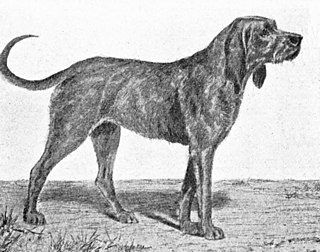
The Chien-gris a.k.a. Gris de Saint-Louis is an extinct breed of dog which originated in Medieval times. Like the Chien de Saint-Hubert, it was a scent hound, and formed part of the royal packs of France, which were composed, from about 1250 till 1470, exclusively of hounds of this type. According to King Charles IX, (1550–1574) they supposedly were introduced to France through Saint Louis, who had encountered these hounds while a prisoner during the Crusades, and subsequently received some as a gift. Old writers on hunting liked to ascribe an ancient and remote origin to their hounds, and these were claimed to be originally from Tartary. They were large, and, even though they did not have such good noses, were preferred by the Kings to the St Huberts, which were said to be only of medium size.
African village dogs are dogs found in Africa that are directly descended from an ancestral pool of indigenous dogs. African village dogs became the close companion of people in Africa, beginning in North Africa and spreading south.